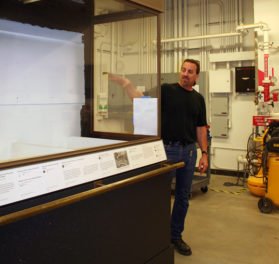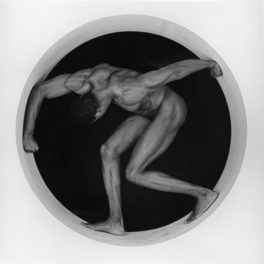Hearsay of the Soul, a video installation by Werner Herzog, lingers with you long after you’ve seen it. In an effort to investigate what makes the work so affecting, we invited a diverse group of experts to articulate how they experienced this multifaceted work, and how they understand it.
Following our talks with independent curator Paul Young and paintings curator Anne Woolett, we turned to musicologist and Getty Research Institute curator Nancy Perloff, who reflects on Herzog’s use of sound and image.

Curator Nancy Perloff, photographed inside Werner Herzog’s installation Hearsay of the Soul
What struck you initially about Hearsay of the Soul?
I was aware by the end of the video that I had immersed myself in something visually and aurally very different.
I paid attention first to what I saw. It wasn’t clear how large the etchings by Hercules Segers actually are, but they had been made large and were moving in a way I found dramatic and challenging to look at. In the second part, my reaction was to focus on the cellist and on sound while being simultaneously aware of the image of the cellist superimposed on the etchings. By the third part, the cellist has vanished visually and I became more focused musically.
Has your perspective changed after seeing Hearsay multiple times?
I like it more and more. My ears pay much more attention. Which isn’t to say that the visuals aren’t as beautiful and surreal and abstract and timeless, because in the musical performances there is an amazing timelessness.
I don’t agree with Herzog’s statement that music morphs into image and image morphs into music. I think they coexist. But I was challenged in a good way by: “What am I hearing?” And then I noticed: “The cellist is still playing!” He maintains a presence by improvising throughout, and that was really exciting to discover. This is a piece about minimalism: about spare visuals and spare, repeated sounds.
Do you think it’s important to sit through the entire piece?
The end is a kind of apotheosis. Maybe that sounds too romantic or spiritual. But the single most remarkable thing is that you lose all sense of time. You lose all sense of what’s characteristic of early music; what’s characteristic of new music; what’s characteristic of avant-garde art, 16th century or 18th century. With Handel at the end of the video, you might think, “How does that relate?” And it just works. And it works because of the clever choice of a recording. And because there is a narrative, even though it takes watching several times to identify it.
Isn’t it unusual for a musician to play over recorded pieces?
Good question. And yes, it is unusual. Certainly you might think of the Kronos Quartet performing an Eastern European work that has a very improvisatory feel to it. And the musical performances in Hearsay of the Soul also have this free quality to them, as if meter and rhythm don’t really matter; it’s more about exploring modal language. The improvisatory element unifies the live and the recorded performances.
What do you mean by “modal”?
“Modal” first emerged in medieval music with different scales that are called “modes.” The music is less defined around any one pitch. A lot of experimental composers don’t want to write tonal music, to have something rooted in any individual key or harmony. So they tend to go back to something more modal so what they play won’t require supporting harmony. If Ernst Reijseger [the cellist of Hearsay] was here, he might disagree. But it just didn’t sound all that tonal to me.
Ernst Reijseger has produced musical scores for various Herzog films in which he is not responding to visual cues; he has also released traditional albums.
And what we’re probably responding to in Hearsay is less Reijseger than Herzog—who is obviously very interested in the relationship between music and visual material. He likes this interplay, and response; whatever one might call it.
Herzog’s cinematic background comes into play. He’s acutely aware of the effect of music paired with powerful visuals.
What would it be like to hear Reijseger perform without any visual stimulus? People are amazed by his virtuosity, that he picks up the cello and seems to be able to play anything. But interestingly, with Hearsay you don’t really think: “Wow,” isn’t he amazing technically.” I was more focused on the quality of the music, because I don’t think I’ve ever heard anything quite like it.
In Hearsay, Herzog layers older works with contemporary music. Is that approach commonplace in music?
What comes to mind is Stravinsky and the way he wrote the score for the ballet Pulcinella. He borrowed music from Giovanni Battista Pergolesi, the Italian 18th-century composer. So when it starts, it’s very tonal, very sing-able, very catchy. And then suddenly you hear Stravinsky harmonies and dissonance and instrumentation, which has nothing to do with Pergolesi. I’m sure there are many other examples.
A lot of contemporary artists are interested in older art.
I think borrowing has always been common practice. I’m thinking about La Monte Young and his well-tuned piano; he’s coming off of a kind of Baroque virtuosic keyboard tradition. But first he was a jazz saxophonist.
____
The final Four Minds on Herzog features video art curator Glenn Phillips on February 12. See the interviews with independent curator Paul Young here, and paintings curator Anne Woolett here.




Comments on this post are now closed.